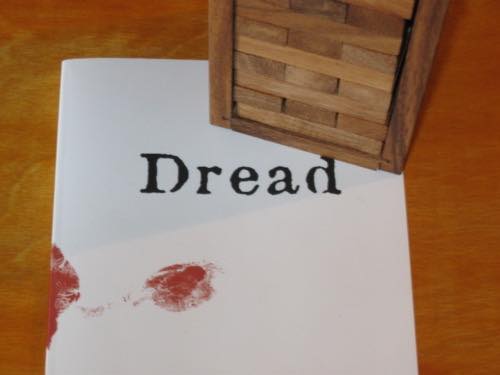Dread. The word conjures images of dark rooms, monsters, death, and many other horror-adjacent Halloween-decor things. It does not conjure images of Hungry Hungry Hippos, Connect 4, or Jenga. Or does it…?
Ok, maybe not the first two. However, staring down a Jenga tower 30 layers tall with a wobbly foundation might. At least, that’s what the creators of Dread would have you believe. Dread is a rules-light tabletop roleplaying system geared toward running horror one-shots. Rather than using a die roll to resolve uncertainty, Dread calls upon its players to pull blocks from a standard Jenga tower. If the player pulls the block, they succeed. If they knock over the tower, they die. You could run an effective game of Dread knowing only these two things, a fact the rulebook makes clear in the first few paragraphs. In my opinion, Dread is by far the best system for running any game where you want your players to feel genuinely afraid.
Why is Dread so effective? The thing that automatically imbues a game of Dread with a sense of horror usually reserved for the Matthew Mercer level game masters of the world is expectations. When the players sit down at the table, one thing is immediately obvious: this tower will be falling. In reality, I’ve run multiple games of Dread where the tower never falls – it doesn’t need to. Players just need to believe that the tower is going to fall, after that nothing matters. To dread is defined as anticipating with great apprehension or fear. The expectation of the Jenga tower collapsing creates this anticipation. Anticipation alone isn’t enough to say that the game induces dread. Another place where expectations become incredibly important in a game of Dread is in its rules. Where the device of the game creates anticipation, the in-game effects of the collapse create apprehension and fear. Traditional tabletop games tend to leave room for interpretation. While a player may have rolled a one on a skill check, the effects of that roll are at the discretion of the game master. In Dread, there is zero room for interpretation. When the tower falls, someone dies. The stakes are clear, the consequences are even clearer. Tasks that would be routine in any other game are literally life-and-death in a game of Dread. The rules of Dread are simple – constructed with the sole purpose of generating a specific emotional response in the players.
Trying to play a horror-themed game in a different system and trying to play a horror-themed game of Dread is night and day. I find that other rulesets gamify the experience far too much. When the players start to think about stats, combat rules, positioning, or anything else, it’s too late. Every additional rule added feels like a wall between the players and the experience. On the other hand, Dread is trimmed down and sleek. Dread lacks the familiar tabletop moments of min-maxing and rules-checking.
Dread is built from the ground up with affect in mind. Every part of the game serves to further a truly dreadful atmosphere. For people who want to tell terrifying stories, but have trouble finding the right mood and keeping it, Dread is perfect.
